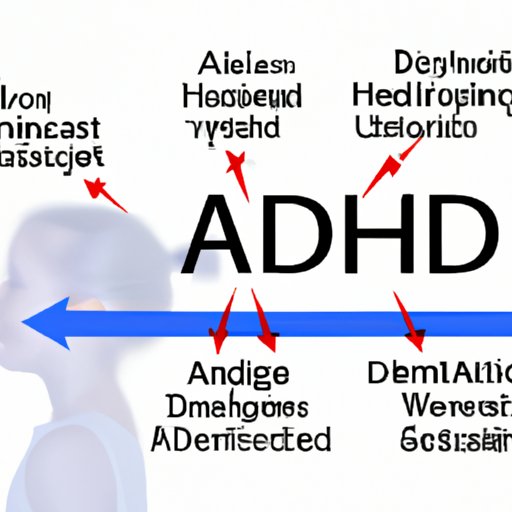
Introduction
Attention-deficit/hyperactivity disorder (ADHD) can be a challenging condition that affects people of all ages. It is a neurodevelopmental disorder that impacts a person’s ability to regulate attention, focus, and control their impulses. ADHD can lead to difficulties in social relationships, work, or school. However, with proper diagnosis and treatment, people with ADHD can overcome the condition’s challenges and live fulfilling lives. The purpose of this article is to explore how you can know if you have ADHD and provide insight into the diagnosis, types, comorbid conditions, and treatment options for ADHD.
Symptoms of ADHD
The symptoms of ADHD can affect different aspects of a person’s life, including work, home, or social settings. The common symptoms of ADHD include inattention, hyperactivity, and impulsiveness. People with ADHD may forget important details, have difficulty organizing activities, and often get sidetracked by irrelevant information. They may also struggle with sitting still, being quiet, or waiting their turn. These symptoms may manifest differently in different age groups and settings.
Children with ADHD may have difficulty paying attention in school, completing homework, or following instructions. They may act impulsively, blurting out answers without being called on or interrupting others. Hyperactive children may have difficulty sitting still, playing quietly, or engaging in organized activities.
Adults with ADHD may have trouble completing tasks on time, organizing their responsibilities, or managing their finances. They may experience forgetfulness, disorganization, and struggle with procrastination. They may additionally have difficulties in relationships, time management and getting started on tasks.
Diagnostic Criteria for ADHD
Formally diagnosing ADHD involves a detailed evaluation of an individual’s symptoms, history, and behavior. The Diagnostic and Statistical Manual of Mental Disorders, 5th edition (DSM-5) is used to diagnose ADHD. It specifies that the person should have persistent and pervasive symptoms of inattention, hyperactivity, and impulsiveness that are not age-appropriate. These symptoms should cause clinically significant impairment in social, academic, and work settings. Symptoms should have been present before age 12.
A clinical diagnosis of ADHD is made by a qualified mental health professional. A self-diagnosis does not replace a clinical diagnosis from a qualified professional. However, taking an online ADHD screening test allows individuals to gain insight into their symptoms.
Personal Stories of ADHD
Many people with ADHD struggled for years before being diagnosed. They may have been called lazy, unmotivated, or forgetful. These individuals often develop negative self-talk, which can lead to low self-esteem and depression. It is essential to recognize the emotional and social impacts of undiagnosed or untreated ADHD. There are stories of people who have gone through various businesses, relationships, and schooling only to realize their innate issue of dealing with ADHD. Sharing and exchanging experiences can help readers identify with others’ experiences and build a sense of community. Resources such as support groups, mental health organizations, and therapy can help.
Types of ADHD
ADHD is classified into three types: hyperactive-impulsive type, inattentive type, and combined type. The hyperactive-impulsive type is marked by hyperactivity and impulsiveness. In contrast, the inattentive type spends a lot of time living in their own world, forget details and have difficulty paying attention. The combined type has symptoms of hyperactivity, impulsiveness, and inattention. While the symptoms may overlap across subtypes, each has distinct behavior patterns. Many individuals will demonstrate a mix of subtype symptoms, which makes the identification process a bit more complicated.
Comorbid Conditions
ADHD can coexist (be comorbid) with other mental health disorders such as anxiety, depression, or learning difficulties. Individuals who have ADHD are at a higher risk of developing one or more comorbid conditions. However, treating only one condition may not lead to an improvement in overall mental health. Addressing comorbid issues early can prevent the spiraling of negative symptoms. Seeking professional help to monitor and treat any comorbid conditions is essential to improving overall well-being.
Practical Advice for People with ADHD
If you suspect that you may have ADHD, seek professional help from a qualified mental health professional. An accurate diagnosis is essential to develop an effective treatment plan. Many ADHD resources, both physical and online, are available. Research on different therapeutic methods like medication and therapy can improve the quality of life for people with ADHD. These resources can guide an individual to better understand their condition, evaluate options and identify resources that can provide support.
Conclusion
It is essential to recognize the symptoms of ADHD, understand its diagnostic process, comorbid conditions, and treatment options. For individuals with ADHD, seeking a diagnosis and treatment from a qualified mental health professional is the first step to manage their symptoms. The diagnosis leads to essential practical effects such as medication, therapy, or more active lifestyle management. There is an opportunity to take control of symptoms and live full and productive lives. Understanding one’s condition can lead to greater self-awareness and provide the necessary skills to achieve mastery over ADHD’s challenges.





